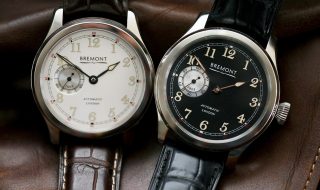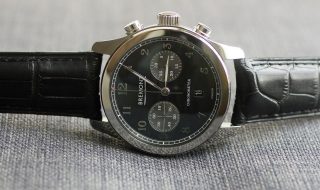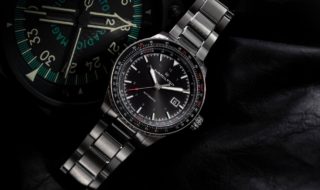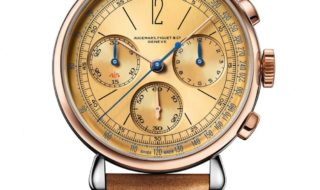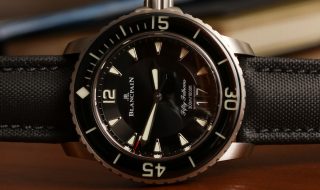Replica Junghans Meister Kalendar Moon Review
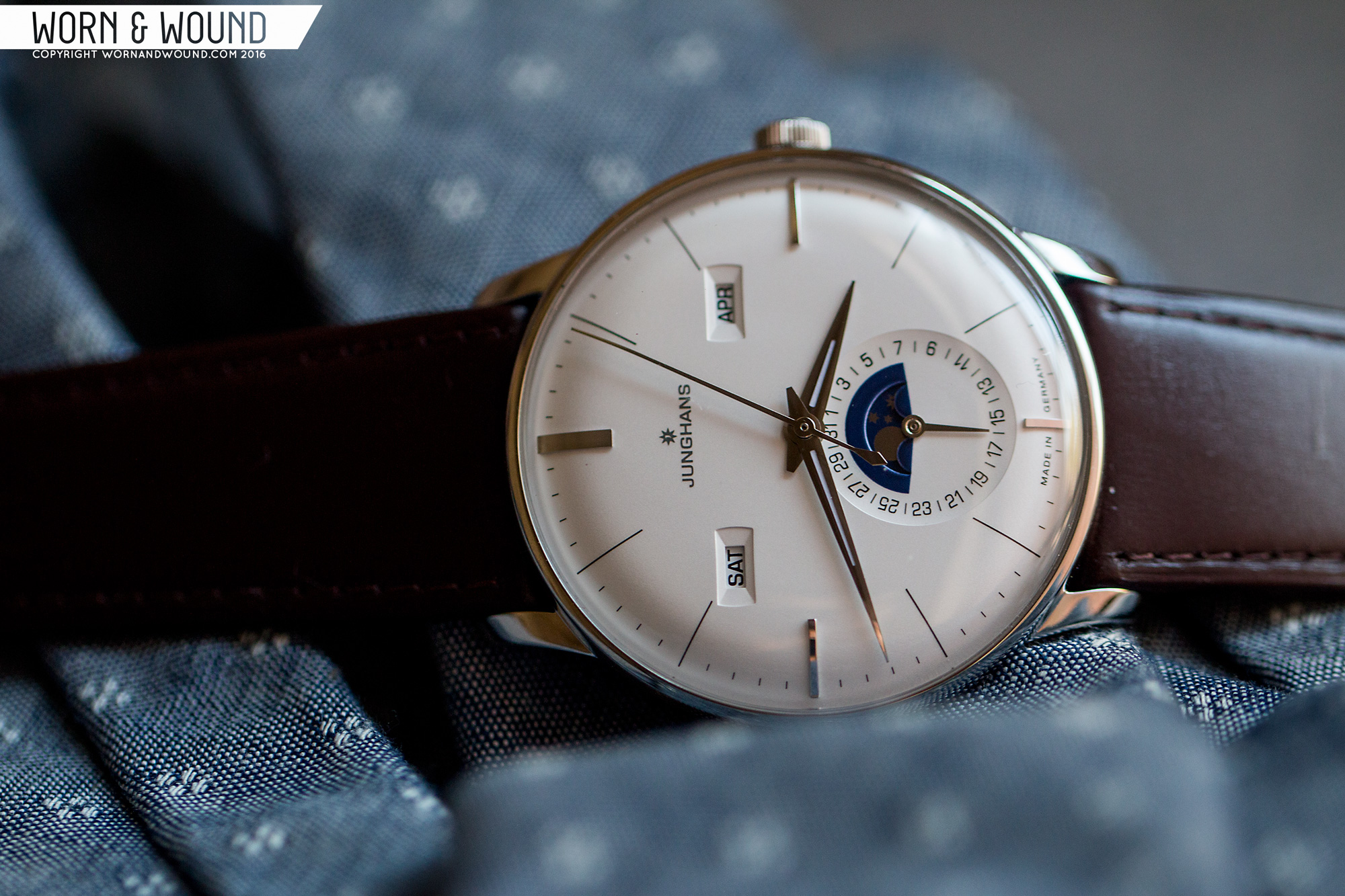
When someone mentions Junghans, in all likeliness one of their impeccable Max Bill replica watches comes to mind. We’ve looked at those a few times on w&w, and will likely do so again in the future. But, Junghans does a lot more than make the Max Bill replica watches, in fact those just scratch the surface. Founded in 1861, Junghans is one of the quintessential German replica watch brands, a brand focused on quality, design and execution while maintaining sensible prices. Of their various lines of replica watches, their Meister series exemplifies these traits. Drawing a bit from the Max Bills, their archives, as well as looking forward, the Junghans Meister replica watches skillfully mix classic replica watch making with both vintage and contemporary aesthetics.
For our first in-depth endeavor into the Meisters, we’re got our hands on the Kalendar Moon, which features a complete calendar module. This increasingly rare complication grants both intrigue and a lot of value to this replica watch by adding day, date, month and moonphase complications to an automatic movement. By rare, I really mean it. This is in fact the first we’ve ever reviewed on w&w. If you’re prone to crawling vintage forums, you’re likely familiar with them as they were more in-vogue in the mid to early 20th century. Now, few brands feature them, most really being annual calendars made by high luxury brands.
Dubbed the J800.3, the Kalendar Moon is powered by a decorated ETA 2824-2 with a Dubois Depraz 9310 module. To my knowledge, few other brands offer a complete calendar in this price range, with only Louis Erard coming to mind. Beyond the movement and function, however, the aesthetics of the Meisters are in a league of their own (ok, the Max Bills are there too). Featuring a beautifully curved case, domed dial and hands and a massive domed acrylic crystal, the Meisters speak to vintage replica watches, but look and feel like modern sculptures on the wrist. At $2,190 the Junghans Meister Kalendar Moon is not inexpensive, but is priced well for a unique German made replica watch with a rare complication.
Advertisement
Case
The Meister Kalendar Moon shares the same basic case design that is featured on the Max Bill replica watches though they are sized specifically for these replica watches. The Kalendar Moon actually measures a bit larger than one might expect with a diameter of 40.4mm. This is tempered by the 45mm lug-to-lug, but it nevertheless wears more like a modern dress replica watch than a classic. It’s also a bit taller than one might expect at 12mm, which is a deceptive number that brings us right into the interesting design.

From the top, it’s all dial, with a slim silver rim and short, contoured lugs protruding out. From the side, the story gets more interesting. The case has a dramatic bowl shape, quickly receding away from the bezel, giving the case the impression of having no sides. This immediately cuts down on the perceived height of the replica watch, in fact making it seem quite thin. The other main character is the massive domed acrylic crystal, which adds a few millimeters of measurable height, but isn’t perceived as solid.
A note on the acrylic. I know this detail sometimes scares people away. They are concerned that the material will scratch the first time they wear it out. While acrylic is softer than sapphire or mineral, it has unique aesthetic qualities that, in my opinion, are worth the risk. There is a luster to acrylic that domed sapphire does not have. And while sapphire can be milled to be the same shapes as domed acrylic, the look just isn’t the same. In a way, acrylic is almost warmer. It has more of a material presence. On a replica watch that draws from the past as well as the present, it’s a bold move for Junghans for sure, but one that adds to the character of the replica watch. Additionally they use a Sicralan coating on the acrylic, which makes it more scratch resistant.




Back to the replica watch… the entire case is polished, which works with the design, playing off of the overall formal aesthetic. On the right side is a small 5 x 2.2mm push-pull crown. It features fine coining on its edge for grip, and a small Junghans star logo on its outside surface. Though the replica watch is an automatic it can be hand-wound and the crown is fairly easy to use despite its small size. Aesthetically, it works with the replica watch’s overall proportions.
Flipping the Kalendar Moon over, you’ll find that the bowl-shaped case leads to a domed case-back that is held on with 5 screws. In the center of the case back is a display window showing the movement inside. Though the base movement is an ETA 2824-2, it does have some nice decoration suggesting it is at least elaboré grade. Unlike a base 2824-2, you can see that all of the surfaces have a nice shimmer to them from plating as well as some twisting grain. Through out the movement are blue screws as well, which add a classic feel. The rotor then has cote de Geneve and an engraved Junghans logo. Given the style of the replica watch and decorations of the movement, it is nice to be able to see it in action. Additionally, there are four sunken pushers, by the outside edge of each lug, which are used for setting the various complications of the replica watch.

Advertisement
Dial
As said before, the Meister Kalendar Moon is all dial, which is a good thing, because it’s gorgeous. The replica watch comes in a few different colors, but the one featured here is pale silver-white. It makes for a dynamic dial that is neither plain white nor metallic silver. Sometimes it looks more metallic, other times more white, but always with an attractive satin sheen. Apart from the subtle coloration, the biggest design feature of the Meister replica watches are their striking domed dials, given everything a three-dimensionality most dials lack.

The primary index consists of applied markers at 12, 3, 6 and 9, and printed markers for the hours and minutes in between. The applied markers are polished steel blocks that follow the curve of the dial, playing off of the sculptural nature of the surface. It’s an amazing detail that will absolutely catch your eye. The printed alternating markers are very attractive too, being long pencil-thin lines, that definitely bring Max Bill dials to mind. Between them are small lines for the individual minutes/seconds. What I really like about this index is the mix of elements. The more classical applied markers combined with the more contemporary printed elements create something unique. It’s vintage yet modern, formal yet graphic.
Moving past the index, the main attraction is the set of complications that create the complete calendar, which are day, date, month and moon phase. At 10 and 2 are windows for the day and month, respectively. The approach to the windows is unique. The day and months themselves are quite small, so to bring more attention to them, as well as use up the space around them, the window are oversized, creating a sort of trapezoidal space for the dates to sit in. The result is that they pull the eye, becoming more legible as a result. Both the day and month are presented in black capital letters on a white surface.




Above 6 you have what is undoubtedly the centerpiece of the dial, the combined pointer date and moon phase sub-dial. There is a lot going on here, but I want to start with simply the execution of the sub-dial. Most sub-dials are stamped into the dial surface. Sometimes with an angled edge, sometimes straight down. Junghans takes a different approach; theirs are inverted domes. The shape is very subtle, just a smooth scallop that meets the dial surface with a perfectly sharp edge, but the effect is dramatic. It breaks the light as it crosses the dial, inverting where light and shadow land. The slight curvature of the surface at the edge then creates an elegant gradient of light as it breaks into the flatter surface below. It has to be the nicest sub-dial design I’ve ever seen, which makes their three-register chronographs all the more visually stunning.
The sub-dial isn’t just a shape however, featuring the pointer date index printed around its edge. The index features numerals for the odd days and lines for the even. They went with a slightly rectilinear typeface for the index, which is a nice change from the more typical choices found in such circumstances. The upper half of the sub-dial contains the moonphase, which has a curious presentation. It has the classic half window with arcs on either side to create waxing and waning moon profiles. The strange part is that the disc is actually very small. They trick the eye by adding additional blue print on the dial, increasing the perceived size of the disk. It’s a clever fix. On one hand, I wish the disk itself was larger, on the other, a moonphase is basically a completely superfluous function that while very intriguing, doesn’t need the legibility of a date. In the end, it’s still very visible, just not as in-your-face as other moonphases out there.

The Meister Kalendar Moon features polished steel dauphine hands for the hour and minute. It’s a classic look that plays off of some of the more vintage elements of the replica watch. The seconds hand is then a long stick also in polished steel. What makes these hands better than average is that the minute and second hands have been curved to match the dial. When looking at the replica watch from an angle, this becomes very clear, and is a gorgeous detail that further emphasizes the dimensionality of the dial. The one thing I could do without, and frankly is my only real criticism of the replica watch, is the lume on the hands. It’s not needed and it’s not very functional as there is no lume on the dial.
Advertisement
Movement
As mentioned in the intro, the Meister Kalendar Moon is powered by the J800.3 caliber, which is a renamed ETA 2824-2 with a Dubois Depraz 9310 module. Since the base is a 2824-2 you can expect it to be an automatic with hacking, hand-winding, 40hr power reserve and a frequency of 28,800bph. Because of the module, the crown only pulls out to one position and is used exclusively for setting the time. In order to set the complications, you need to push the four indented pushers on the back of the case. To do this, I recommend using a toothpick, as it’s pointed and strong enough to depress a pusher, but too soft to scratch the metal should you slip. Setting the functions is pretty straightforward from there. Each push moves its respective function forward one unit, whether it be day, date or month. The moonphase is a bit less precise, just jumping forward a bit, but it’s easy enough to set with a reference image.

Straps and Wearability
The Meister Kalendar Moon comes mounted to a 21mm brown leather strap. Yup, it’s 21mm, which does make finding secondary straps a bit annoying, though many 22mm, and even some wider than aver 20mm will fit fine. The strap itself is a dark chocolate brown with a slight taper, matching stitch and painted edges. The leather has been corrected, so it has a very flat even surface, giving it a formal appearance. It’s well made and quite comfortable with a reassuring stiffness, but pleasantly thin profile.
On the wrist is where the Meister really shines. The 40.4mm diameter gives the replica watch a lot of presence, but the short lugs make it feel and wear smaller. It’s almost like a lugless 40.4, especially since the strap sits so close to the case. Perhaps the size makes it more “business-casual” than true dress, but I would happily wear it as a dress replica watch with a suit. What the size does for it is actually make it more versatile, as it doesn’t seem too formal to wear on a normal basis either. Perhaps I’m picky, but when I see someone with a very formal replica watch, say a Lange or something (I’m in NYC, it happens) but with jeans and a t-shirt, I can’t help but feel like the replica watch is out of place. Here, you can get away with most anything.

More over, it’s on the wrist in the light of day while walking around, in motion, that the curves of the dial and crystal really come to life. It’s ever changing, and much more dynamic than your average flat dialed replica watch. Adding the complications in to that just increase the intrigue of the dial.
Advertisement
Conclusion
The Junghans Meister Kalendar Moon is a perfect example of a modern presentation of a very classic concept. They took elements from 20th century replica watches and a set of complications that is typically found on replica watches with very formal leanings, and executed it with a finessed, modern touch. One that draws on a graphic foundation from their Max Bill line, but brings in classic elements to create something new. In doing this, Junghans has created a unique replica watch that aesthetically has few rivals.

For $2,190 the Meister Kalendar Moon is a fair price for the package. One rarely finds moonphases for under that price, let alone complete calendars, which are all but non-existent. So, if you want those complications in a replica watch, what Junghans has created will likely be a total winner for you, and one worth saving a bit for. Should you like the overall aesthetic, but don’t want the complications, for $1,290 they also make a simple hand wound model that will get you much of the same feel (including that sexy sub-dial). It’s also 37mm, should the 40.4mm really not be your thing. On the flip side, they also have several chronographs within the Meister line, including the stunning telemeter model, as well as the new driver series coming out soon… So, long story short, if you like the Meister aesthetic, there is likely a model for you.
